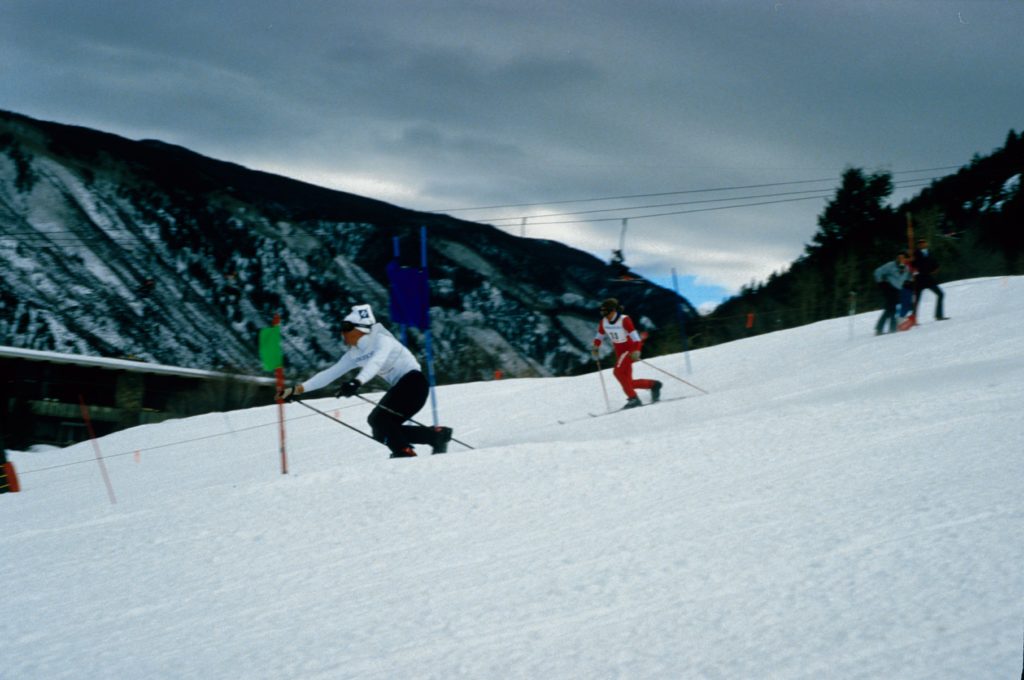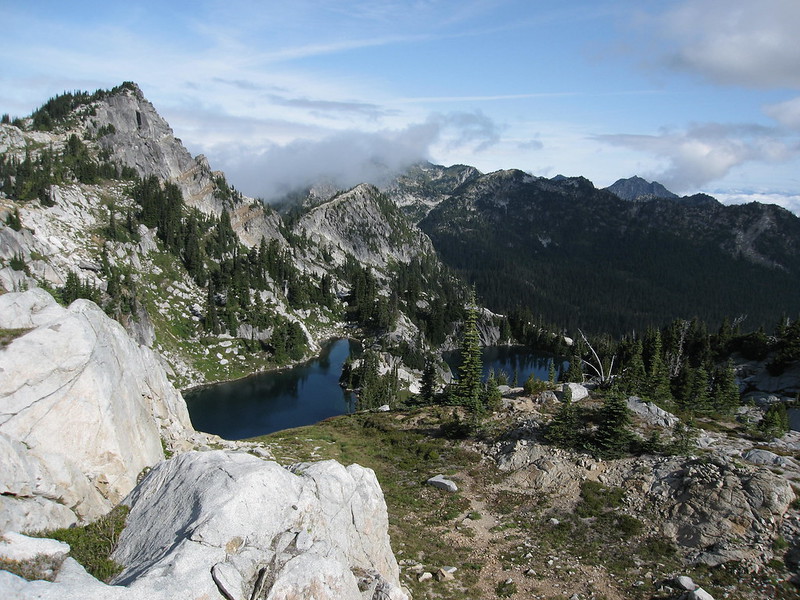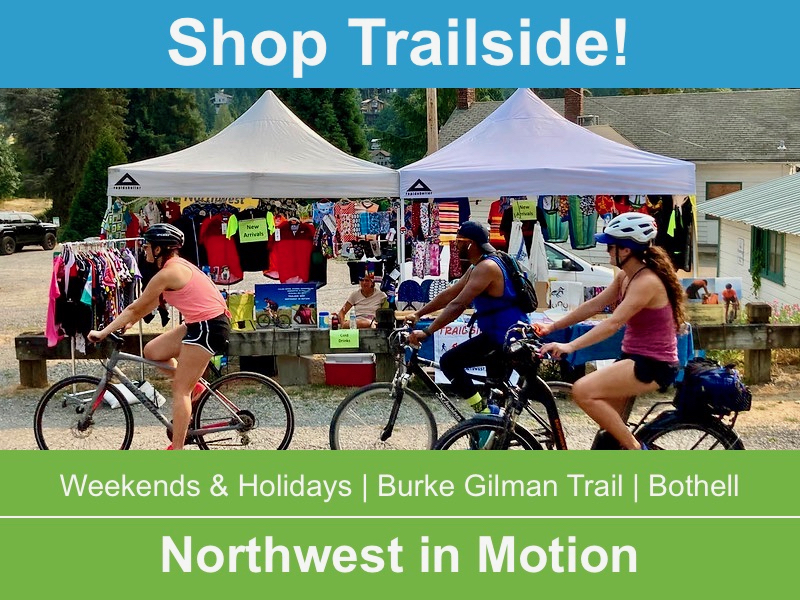A traverse of the Cascade crest from Mt. Baker to Mt. Rainer was first envisioned in the early 1980s by legendary Cascade skier, mountaineer, and historian Lowell Skoog. Skoog’s version of the traverse was comprised of ~18 segments, and after working on the project for 25 years, he finally completed it in 2007. His vision and accomplishment has been an inspiration for younger activists, specifically mountaineering photographer Jason Hummel and professional snowboarder Kyle Miller who are the second and third people to have completed the traverse.
Nooksack Traverse, Watson Traverse, Solo Glacier Peak and solo Paradise to Carbon
Hummel completed his version of the traverse in 2017 after a 14-year effort.
Miller completed his version of the the traverse in 2018 after a 10-year effort.
Jason and Kyle are frequent backcountry collaborators, and there was considerable overlap between their two efforts. Kyle estimates they did 90% of the traverse together.
Kyle’s path to snowboarding and alpine adventure came about as a result of personal cataclysm.
“Sadly I was involved in a tragic car accident and had severe PTSD. Shortly after that a friend introduced me to snowboarding at Crystal Mountain. A few days later I had a season pass. I started touring that spring when the resorts closed but the mountains were still covered in snow. When I first started splitboarding there were only a handful of us. We felt like outsiders in the ski touring community. Over the years I kept going deeper into the unknown. Many years of snowmobiling into White River on Mt. Rainier’s NE side with my friends Boot and John Cocci gave me a drive for solitude I could only find in the mountains. Eventually I met Jason Hummel through a mutual friend. We were both jobless, both of us had big dreams about mountains, and so we became natural partners. Peak bagging slowly transitioned to working on traverses.”

As a result of the popularity of his website, 37 year old Miller has cobbled together a life as a professional snowboarder. Although he grew up in Kent, WA, he now lives with his wife in Rovaneimi, Finland.
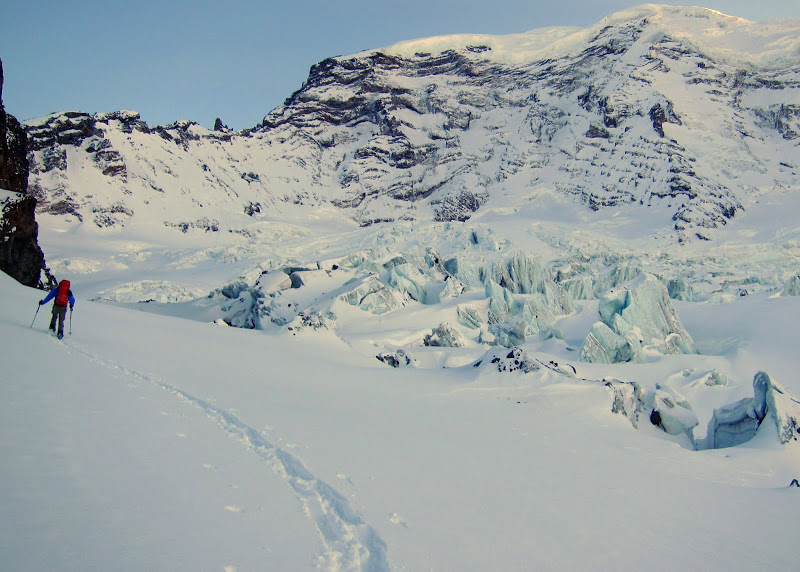
“I was splitboarding and going on missions for well over a decade before the sport became popular. Companies like Eddie Bauer, which is my main sponsor, started sending me emails showing interest in my expeditions.”
Hummel and Miller’s collaboration on the Cascade Crest Traverse ranged from pioneering a 16 day, ~120-mile version of Skoog’s vision for an American Alps traverse, to a one-day traverse over Mt. Baker to Mt. Baker Ski Area.
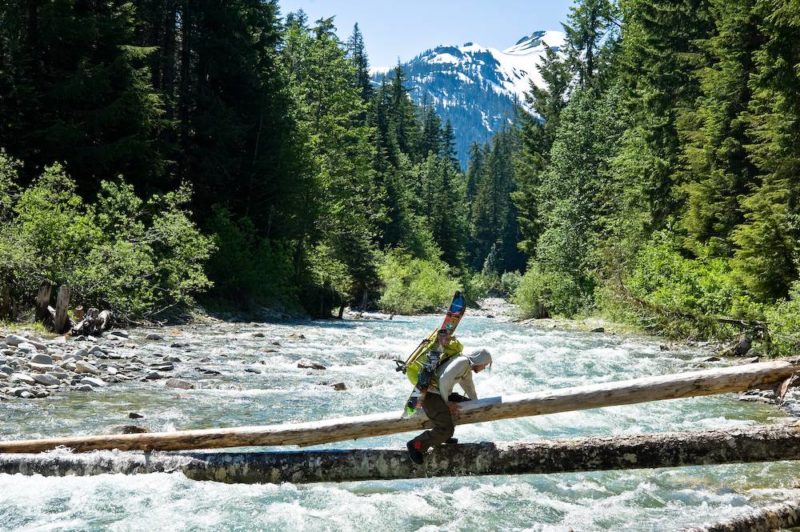
In contrast to the way we tend to quantify every aspect of our athletic endeavors these days, the qualitative style of alpine travel is often more important than speed. Or put another way, exceptional athleticism enables a more refined artistic expression of movement through the alpine. Out in the middle of nowhere, these remarkable athletes express themselves in relative anonymity.
The tools used to move in the alpine are essential components of the art. Skoog uses backcountry skis, which are similar to the kinds of skis used at ski areas. Hummel rides telemark skis, aka “free heel” skis, on which the boot only attaches at the toe area. Miller uses a special kind of snowboard called a “splitboard” that can be broken apart lengthwise and used like cross country skis to slide on flat and uphill terrain. In skiing and riding, the way you move your body and the imprint you leave in the snow is regarded as artistic expression.
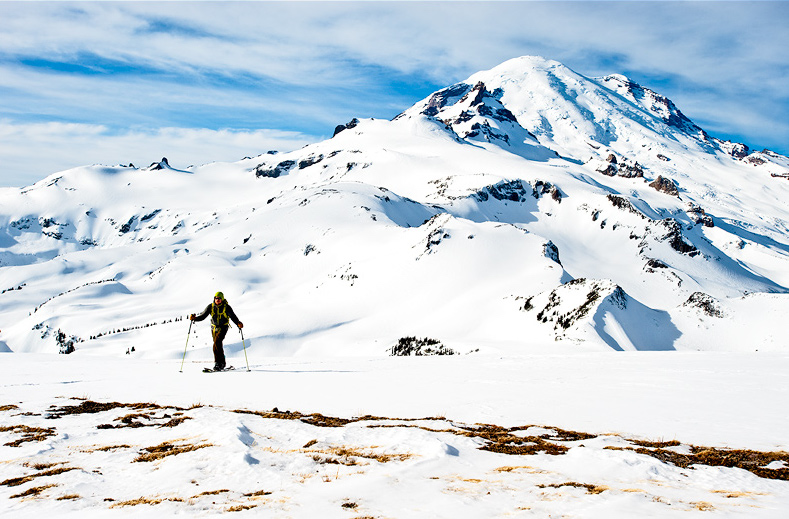
Route selection is another important aspect of alpine artistic expression. Although based on Skoog’s initial vision, all three efforts were slightly different. Skoog’s interpretation emphasized linking segments that favored ski touring. Hummel and Miller favored segments that had the most aesthetic ski and snowboard descents. And, Kyle noted that “…when people hear the word traverse they think of endless miles of sidehilling, but many of the segments were all up and down…”
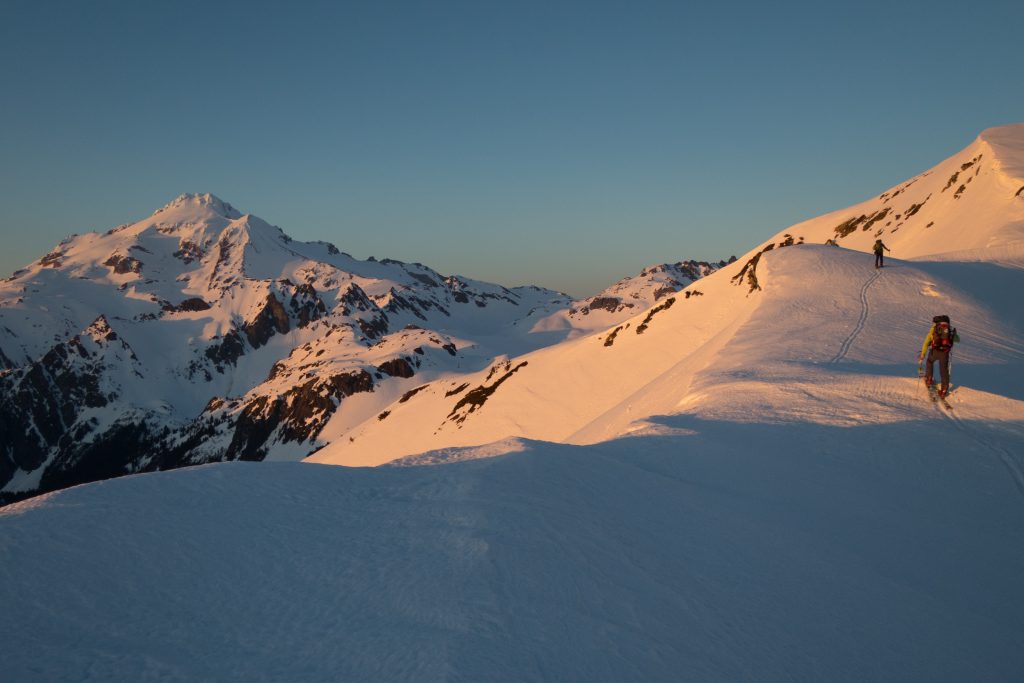
According to Kyle, the project came together slowly over time.
“For many years it was a piece-to-piece thing with no big objective in mind. We were simply exploring areas new to us and really appreciated the style of ski traverse. After about 10 years of doing these traverses it became ‘well…if I only do 6 more I’ve got it.’ The last two years were hard because I was living in Finland and would fly to Washington for a month doing day tours and just waiting for the weather to break. Those were testing times but I did my last traverse just 2 days before flying back to Finland. It takes one skill to climb and ski a peak, but there are so many different aspects to look out when traversing for multiple days. I used to joke that the mountains were my canvas and how we put these traverses together was our art. You’re left with a blank page on a topo and every uphill and downhill track is your paint.”
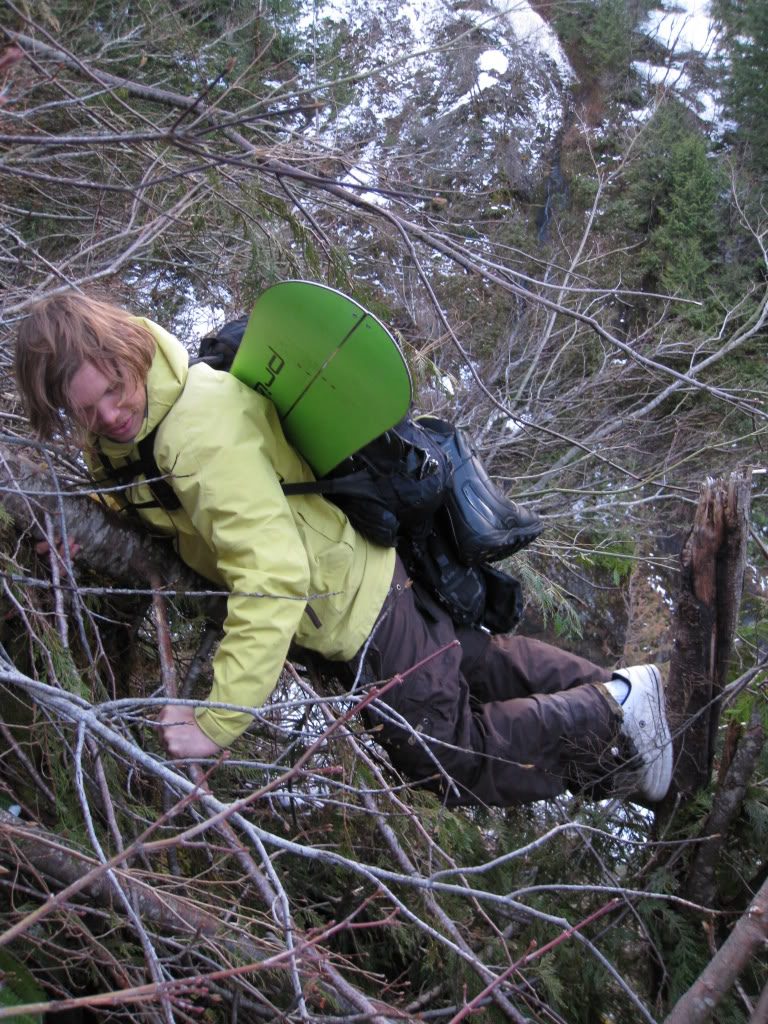
Jason helped keep Kyle motivated.
“I’d gotten Kyle to go on many of these adventures, and eventually conned him into finishing it. I ended up completing it a year before he did, but I started nearly a decade earlier. Our two routes differed in places, and also differed from the original route Lowell Skoog did as a tribute to his brother, Carl Skoog, who was a well-known photographer and ski mountaineer. While I appreciated Lowell’s route and reveled in following those tracks, I had to remember and respect that this route was a memorial to a skier, friend, brother, etc., now gone. Along the way, I imagined that what I shared with my friends and my brothers was also something to hold onto and cherish.”
Jason described his motivations:
“Both of us needed our own reasons to go on these (point to point) traverses. Sure, they added the bonus of not having to return the way you’d come…the devil you know kinda philosophy…but we needed more. For me, it was a reason to explore the unique lines that exist out there, small and big alike. You can ski a line in and around a ski area, which may even be more gnarly, or bigger, but it’s the placement of the lines on far away peaks that made them special and turns to remember. My photography was a way for me to tell the story.”
Another interesting element of Hummel and Miller’s expeditions is that they often incorporate multiple modes of transportation getting to and from each route. For example, the traverse from Mt Daniel to Stevens Pass included a 14+ mile snowmobile to get to the start, and at the finish they hitchhiked from Stevens Pass to Everett where they caught transit buses home. Train travel has also been part transportation mix.
Kyle elaborated:
“Taking the train…this is something I have gotten used to over the years as it goes nowhere near the actual ski resort BUT is on the route from Tacoma to Crystal so it allowed me to have options for carpooling from both Seattle and Tacoma and without the use of a car myself it was a good viable option. I have used metro buses on so many trips, taking multi-day gear on 2 buses through the heart of Seattle to meet up with my friend Ben on Fridays for weekend adventures.”
Kyle Miller’s Cascade Crest Traverse Segments, Organized South to North:
Highway 410 to Dege: Sourdough Traverse 1 Day 6 Miles with Jason Hummel 2012
Dege to Sunrise Sunrise Base Camp 3 days with Jason Hummel 2014
Carbon River to Sunrise: Osceola Traverse 4 Days 36 Miles with Jason Hummel 2013
Paradise to Carbon River Solo Traverse 7 Days 45 Miles Solo 2013
Paradise to Crystal Mountain 3 Days 24 Miles with Jason Hummel 2012
Crystal Mountain to Stampede Pass 4 Days 35 Miles with Jason Hummel 2017
Stampede Pass to Snoqualmie Pass: The Patrol Race 1 Day 17 Miles with Jason Hummel 2014
Snoqualmie Pass to Mt. Daniel: Alpine Lakes Traverse 7 Days 70 Miles with Jason Hummel 2010
Mt. Daniels to Stevens Pass: 14 Lakes Traverse 4 days with Jason Hummel 2016
Glacier Peak Wilderness to Stevens Pass: The Poet’s Traverse 5 days 2018 with Jason Hummel
North Fork of the Sauk to White Chuck River over Glacier Peak: The Abandoned Traverse Solo 7 days 2013
“…Skinning on the trail was nothing less than a nightmare. Steep, Icy, hundreds of fallen old growth and all this directly above the White Chuck River. I used every skin technique I have ever learned. Veggie belays had become my best friend and I crawled,stemmed, flipped and rotated well over 100 times through the abandoned trail…”
Ten Peak: A Circumnavigation of the Dakobed Range 7 Days 31 Miles with Jason Hummel 2013
White Chuck River to Highway 20: American Alps Traverse 16 Days and 120 miles 2013 with Jason Hummel
The American Alps ski route was initially envisioned in the early 1990s by Lowell Skoog, his late brother Carl, and Jens Kieler. The route begins on the North Cascades Highway (Hwy 20), and passes through North Cascades National Park to the village of Holden. From Holden it connects with the Suiattle High Route, crosses the summit of Glacier Peak, and finishes on the White Chuck River Road near Darrington.
Jason says this traverse was a favorite:
“The most memorable section was the American Alps Traverse, which I’m sure Jason would agree is his favorite. It was the longest continuous traverse we made, adding up to 16 days and 60,000 vertical feet of gain, over 120 miles. To pull off a traverse like this takes a combination of conditions to align. Sure, you can go when they don’t, but insofar as memorable is concerned, I appreciate some nice weather, epic skiing and those kind of days that scream, ‘Hell yeah.’ This trip had it all, and was long enough to really fall into the stride of each day without the worry of time and endings and work and so forth bogging down the moment. It’s what I love most. We had a lot of that. Lastly, it tied together a massive section of the Cascade Crest, many places I’d spent time skiing since I was a teenager, and wrapped them all up into one memory. That to me is special. Moments of friends no longer with us, and those that have moved on to different places in life. Good memories all.”
Highway 20 to Hannegan Pass: A Splitboard Certified Traverse of the Pickets 7 days with Jason Hummel 2013
“It all started with a near death experience.”
Hannegan Pass to Mt. Baker Ski Area: Nooksack Traverse 3 days
Coming soon.
The Watson Traverse: Mt. Baker to Mt. Baker Ski Resort 1 day 17-Miles with Jason Hummel
The Watson Traverse was the final piece in the puzzle.
More about Jason Hummel:
Expeditions 1999 to 2003
Expeditions 2004 to 2013
Expeditions 2014 to present
Alpine State of Mind Book
Alpine State of Mind Photos
Traversing the American Alps: A Photographer’s Account
More about Kyle Miller:
Where is Kyle Miller?
FreeRider Film profile of Kyle Miller
Kyle Miller Full Part movie
Kyle snowboards year round, all around the globe:
“For the past few years I’ve been doing a lot of traveling to New Zealand where I did an 18 day ski traverse from the East side of Mt. Cook National Park to the West Coast. I did a two-week ski traverse of the Lyngen Alps in Norway. I’ve also been touring around NW Russia, and smashing as much powder as possible in Japan. I’ve been doing these loops for the past 5 years and each of them are a gem in there own ways.”
